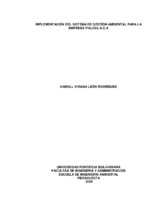| dc.contributor.advisor | Castillo Pérez, Consuelo | |
| dc.contributor.author | León Rodríguez, Karoll Viviana | |
| dc.coverage.spatial | Seccional Bucaramanga. Universidad Pontificia Bolivariana. Escuela de Ingenierías. Facultad de Ingeniería Ambiental | spa |
| dc.coverage.temporal | 2009 | |
| dc.date.accessioned | 2013-07-16T21:53:41Z | |
| dc.date.available | 2013-07-16T21:53:41Z | |
| dc.date.created | 2009-07-21 | |
| dc.date.issued | 2013-07-16 | |
| dc.identifier.uri | http://hdl.handle.net/20.500.11912/469 | |
| dc.description | 171p.: (pdf); il; tablas; gráficas; anexos | spa |
| dc.description.abstract | Las actividades diarias y operaciones de ITALCOL se organizan, planean y controlan por medio de procedimientos que permiten el excelente funcionamiento de la planta y el cumplimiento de los objetivos y políticas de la compañía, sin embargo, la mayoría de las operaciones y actividades no tienen ningún tipo de control provocando efectos negativos al medio ambiente en el que se esta generando la actividad. Por tal motivo se vio la necesidad de implementar un sistema de gestión que permita evitar, mitigar y/o corregir los impactos perjudiciales para el medio ambiente y los seres humanos, y contribuir al mejoramiento continuo y prevención de la contaminación. Para comenzar con la estructuración del sistema de gestión ambiental fue necesario realizar la planificación del sistema, que permitió cuantificar los recursos y el tiempo que se invertirán para la efectiva implementación, desarrollando un plan para cumplir con los objetivos que cuenta con el establecimiento de un procedimiento para identificar los aspectos ambientales, los requisitos legales, establecer y mantener los objetivos y metas ambientales al igual que un programa ambiental para alcanzar estos objetivos y metas. Ya planificado el sistema se prosiguió con la segunda etapa, la implementación, en la cual se estableció el organigrama del Departamento de Gestión Ambiental y la matriz de responsabilidades para cada una de la personas de la compañía; se definieron las actividades de capacitación y se alimentaron los indicadores tanto del programa de capacitación y de los otros programas implementados los cuales permitieron evaluar el comportamiento de las actividades implementadas y el funcionamiento del SGA. La formulación de los programas ambientales definió los objetivos y metas para mejorar el desempeño ambiental, utilizando como base principal la evaluación de los impactos ambientales y se establecieron los indicadores de gestión para medir periódicamente cada uno de los objetivos y metas establecidos. | spa |
| dc.description.abstract | The daily activities and operations ITALCOL are organized, planned and controlled
through procedures that allow the plant excellent performance and meeting the
objective and policies of the company, however, most of the operations and
activities have no type of control, causing adverse effects to the environment in
which the activity is being made. For this reason was observed the need for
implementing a management system to prevent, mitigate and/or correct the
adverse impacts to the environment and humans beings, and contribute to
continuous improvement and pollution prevention.
To start with the construction of the environmental management system it was
necessary to make the system planning, which allowed quantifying the resources
and time that had to be spent for the effective implementation of the SGA. It was
done by developing a plan to meet the objectives, which takes into account the
establishment of a procedure to identify environmental aspects, legal requirements,
establish and maintain environmental objectives and targets as well as an
environmental agenda to achieve these objectives and goals. Once the system
was planned, the second stage continued with the implementation, in which the
organization chart of the Department of Environmental Management and the matrix
of responsibilities for each person of the company were established, the training
activities were defined feeding both indicators of the training program and other
programs implemented, which let us evaluate the performance of the implemented
activities and the proper functioning of the SGA.
Environmental programs were developed where the objectives and goals to
improve environmental performance where defined, using as a main base the
assessment of environmental impacts, and the management indicators were
established to measure periodically each one of the objectives and goals set. | |
| dc.language.iso | es | |
| dc.rights | Attribution-NonCommercial-NoDerivatives 4.0 International | * |
| dc.rights.uri | http://creativecommons.org/licenses/by-nc-nd/4.0/ | * |
| dc.subject | Ingeniería ambiental | spa |
| dc.subject | Tesis y disertaciones académicas | spa |
| dc.subject | Gestión ambiental | spa |
| dc.subject | Impacto ambiental | spa |
| dc.title | Implementación de un sistema de gestión ambiental para la empresa ITALCOL S.C.A | spa |
| dc.type | workingPaper | spa |
| dc.rights.accessRights | openAccess | spa |
| dc.type.hasVersion | publishedVersion | spa |
| dc.identifier.instname | instname:Universidad Pontificia Bolivariana | spa |
| dc.identifier.reponame | reponame:Repositorio Institucional de la Universidad Pontificia Bolivariana | spa |
| dc.identifier.repourl | repourl:https://repository.unab.edu.co/ | |


